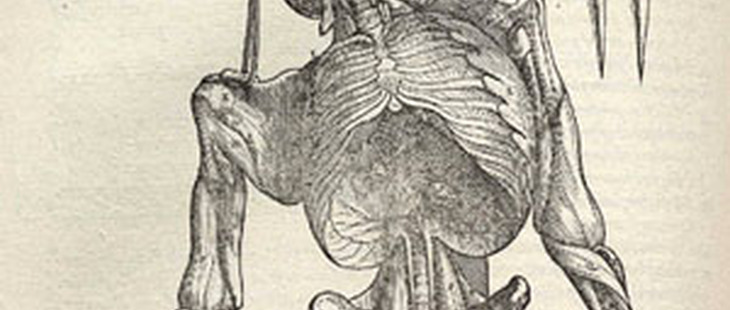
From De humani corpus fabrica, Andreas Vesalias’s 1543 anatomical text. You have to feel for the fisherman. On May 3rd, 1844, the Toronto British Colonist reported that, while angling for his dinner in the Toronto harbour, he hooked a submerged barrel. With some effort he pulled it to the surface and, his curiosity getting the better of him, pried the lid open. Inside lay a dismembered and rotting human body. The coroner ruled quickly: this was no crime. He had likely conferred with some doctor friends who quietly told him that this corpse belonged to a science project. Clearly, he later told the paper, this was the work of some enterprising medical student or professor who sought to speed up the body’s deterioration. Clinicians needed to study skeletons, this was how one procured them: expose the body to the elements and let nature render flesh from bone. Nothing to see here, just medicine at work. Early Toronto, however, disagreed. The thought of a rotting, dismembered body floating in the same harbor that people fished, swam, and drank from was, to put it mildly, off-putting to Toronto’s citizenry. But a darker fear also animated their anxieties. What was this body’s provenance? How had it been acquired? For decades (and for decades to come) doctors stole the bodies of Toronto’s dead from their graves. In order to pass medical school students were (and still are today) obliged to dissect at least one, sometimes two, cadavers; but, unlike today, no one back then was willing their remains to science. Under the cover of darkness, bands of medical students and their associates (known, poetically I think, as resurrectionists) would dig holes above fresh graves, cut a hole through the casket, ram a hook beneath the collarbone and pull it from the earth. As one Trinity Medical College professor noted “our school has been plentifully supplied [with bodies] chiefly through the aid of students.” Further afield one doctor wrote in his memoirs that at McGill you could, in lieu of cash, pay your tuition upon presentation of a cadaver or two. Grave robbing is one of those things that no one is ever going to be pleased about, but, in the 19th century, purloining the dead for medical purposes had a special morbid resonance. For many, the somatic integrity of the body was a prerequisite for its ascension to God. At the gates of St. Peter a dissected and flayed body would be unrecognizable, and its soul, though through no fault of its own, would be consigned to an eternity of purgatory. Taking note, the state added dissection to its coercive power arsenal. For those that 19th century law deemed to be the worst of the worst, judges could tack on dissection to a death sentence: at times, it decreed, punishment must transcend the corporeal realm. From 1801 to 1837 at least seven people in Upper Canada were dissected for their crimes (ghoulish trivia fans might know that the first woman ever executed in Canada was also the first to be sentenced to dissection). That the anatomization of a body was associated with crime undoubtedly added to its stigma, and was a contributing factor to people’s reluctance to turn their dead selves over to the sawbones. And given how few bodies were actually turned over to the doctors by the criminal justice system, demand, in the first half of the century, outstripped supply. Even after the Anatomy Act was introduced, a law that ordered all unclaimed corpses from hospitals or prisons be turned over to medical schools (which, reports suggest, caused tremendous anxiety amongst the city’s immigrant community – the poor Scot or Irishman was the one most likely to die alone), formal mechanisms failed to satisfy the medical establishment’s requirements. Hence the bodysnatchers. By the mid 1840s a tidy profit could be made from corpse related transactions. Depending on the doctor, the season (the frozen ground constricted supply), and the nature of a specific medical school’s curriculum, a body could be worth between $15 to $50 (adjusted for inflation that works out to $320 to $1,000 today). Three decades later a full fledged international trade developed: in 1870 the New York Times alleged that bodies were being shipped to New England by way of Montreal. But back to the fisherman. Death is the great leveller, but body snatchers were no democrats. The privileges of wealth in early Toronto afforded those who could pay a certain measure of security for their final slumber. It was during this period that locking metal caskets were first marketed, or that bourgeois cemeteries began employing guards. If you were a medical student, then, it made most sense to pursue only one type of body: the poor one. Occasionally the poor fought back. Catching some medical students attempting to raise a friend’s body, soldiers associated with the Canadian Rifle Corps engaged in a brief gun battle in the 1849 and, the next day, threatened to drown anyone they caught associated with the aborted theft. But these flare-ups were exceptional and, throughout the century, a quiet antagonism developed between Toronto’s new rich doctors and the city’s downtrodden. And that is what must have flashed through the fisherman’s mind as he peered into the barrel: does this grim end also await me?














